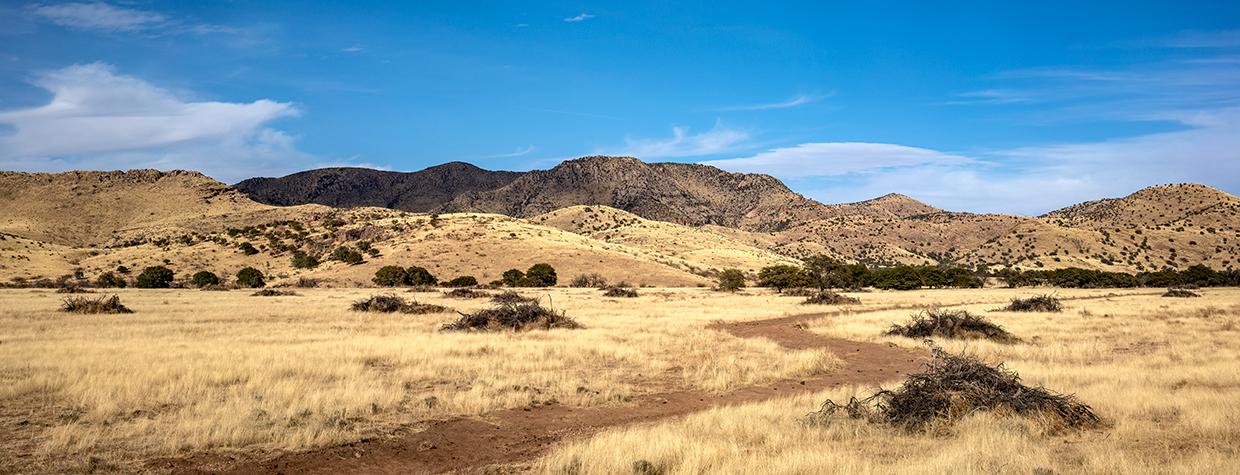Johnny Ringo, notorious outlaw and enemy of Doc Holliday and Wyatt Earp, met his end in the Chiricahua Mountains in July 1882. On this fact, people agree. And while the manner of Ringo’s death is debated even today, there’s no doubt about Ringo’s final resting place: beneath a pile of rocks along Turkey Creek Road, which climbs into the Chiricahuas from the west. Ringo’s grave is a highlight of this 10-mile drive, but the route also offers an easy meander into the varied flora and terrain of this “sky island” range.
The road begins on State Route 181 just southeast of the hoodoos and hiking trails of Chiricahua National Monument. Heading east, you’ll first pass a vineyard, one of many that support this area’s burgeoning wine industry, before crossing a one-lane bridge over Turkey Creek — the first of several such crossings along this route. Next is a flat section filled with tall grasses that will wave on a windy day, and on the left are the grass-covered buttes that form the Chiricahuas’ foothills.
At Mile 4.3, you’ll cross another bridge over the creek, and a half-mile after that, you’ll reach Ringo’s gravesite, which is marked by a signed gate along the road. A short walk takes you to the grave, which is shaded by several tall trees. A historical marker explains that a teamster discovered Ringo sitting in the fork of a nearby oak tree with a bullet hole in his right temple, his revolver still in his right hand. The outlaw’s death was ruled a suicide, but theories that he was murdered by Earp, Holliday or someone else have persisted over the years. Regardless, Ringo was buried near the spot, and that’s where his remains remain.
From here, Turkey Creek Road narrows and gets a bit rougher as it climbs into the mountains, and alligator junipers soon appear along the road. You’ll get views of the surrounding peaks before passing a large willow at Mile 6.3; from there, piñon pines start to mingle with the junipers. Keep an eye out for wild turkeys and white-tailed deer, along with a variety of bird species.
Past a tunnel-like canopy of trees at Mile 8, you’ll enter the Coronado National Forest, where a sign warns of black bear activity in this area. The road gets even rougher from here — although you still can do it in most cars in good weather — and climbs a bit higher, into a section of ponderosa pines and oaks, along with a few tall, spindly Arizona sycamores. There are numerous trailheads along the road, but also keep an eye out for the ruins of a stone cabin and a footbridge over Turkey Creek around Mile 9, on the right.
It’s another mile or so from the ruins to Sycamore Campground, the endpoint for this drive. Here, tall ponderosas, oaks and the campground’s namesakes shade a handful of well-maintained campsites, and there are charcoal grills (which can be used only if fire restrictions are not in effect) and vault toilets. The creek runs right past the campground, and when water is flowing over a series of small waterfalls, you’ll probably conclude the Chiricahuas are a great place to hang out. Unless you’re Johnny Ringo.
tour guide
Note: Mileages are approximate.
Length: 10 miles one way (from State Route 181)
Directions: From the entrance to Chiricahua National Monument, go west, then south on State Route 181 for 13.3 miles to Turkey Creek Road. Turn left (east) onto Turkey Creek Road and continue 10 miles to Sycamore Campground.
Vehicle requirements: A high-clearance vehicle, such as an SUV or truck, is recommended, but the road is passable in most vehicles in good weather. Do not attempt the drive after recent rain or if rain is in the forecast.
Special considerations: Johnny Ringo’s grave is on private property, and the posted visiting hours are 8 a.m. to 6 p.m. daily. A $15 fee (cash or check) is required to camp at Sycamore Campground.
Warning: Back-road travel can be hazardous, so be aware of weather and road conditions. Carry plenty of water. Don’t travel alone, and let someone know where you are going and when you plan to return.
Information: Douglas Ranger District, 520-364-3468 or fs.usda.gov/coronado

